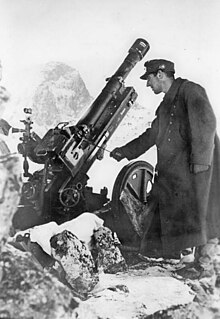7.5 cm Gebirgsgeschütz 36
| 7.5 cm Gebirgsgeschütz 36 | ||
|---|---|---|
Breech Horizontal sliding-block | | |
| Carriage | Split trail | |
| Elevation | -2° to +70° | |
| Traverse | 40° | |
| Rate of fire | 6-8 rpm | |
| Muzzle velocity | 475 m/s (1,560 ft/s) | |
| Maximum firing range | 9,250 m (10,120 yd) | |
The 7.5 cm GebG 36(
Development and description

The 7.5 cm GebG 36 was designed by

The design of the 7.5 cm GebG 36 was relatively conventional in regard to the gun itself, with its standard German horizontal
Because of its lightness the 7.5 cm GebG 36 would jump when fired at low angles as the recoil forces would force the gun's trail spades to act as a fulcrum and lever the wheels upwards. In fact Charge 5, the largest propellant increment, was forbidden to be fired at angles under 15° because the gun would jump excessively. Firing at higher angles was perfectly safe as the ground absorbed any residual recoil forces not absorbed by the recoil system.[3]
Ammunition

The 7.5 cm GebG 36 fired a wide variety of ammunition, with the notable exception of a conventional
Organization
The guns were organized into batteries of four guns each with two or three batteries per battalion. A mountain artillery regiment (Gebirgs-Artillerie Regiment) would have anywhere from one to three battalions equipped with the 7.5 cm GebG 36.[6]
Notes
- ^ Gander and Chamberlain, p. 289
- ^ "German Weapon and Ammunition Production 1 Sep 1939-1 Apr 1945". Archived from the original on 2 March 2009. Retrieved 28 May 2009.
- ^ a b c Hogg, p. 32
- ^ Zentner, C. Soldaten im Einsatz. Jahr Verlag Hamburg (1977). p. 115
- ^ Hogg, pp. 32-3
- ^ "German Army Organizations 22 June 1941". Retrieved 29 May 2009.
References
- Chant, Chris. Artillery of World War II, ISBN 0-7603-1172-2
- Engelmann, Joachim and Scheibert, Horst. Deutsche Artillerie 1934-1945: Eine Dokumentation in Text, Skizzen und Bildern: Ausrüstung, Gliederung, Ausbildung, Führung, Einsatz. Limburg/Lahn, Germany: C. A. Starke, 1974
- Gander, Terry and Chamberlain, Peter. Weapons of the Third Reich: An Encyclopedic Survey of All Small Arms, Artillery and Special Weapons of the German Land Forces 1939-1945. New York: Doubleday, 1979 ISBN 0-385-15090-3
- Hogg, Ian V. German Artillery of World War Two. 2nd corrected edition. Mechanicsville, PA: Stackpole Books, 1997 ISBN 1-85367-480-X
